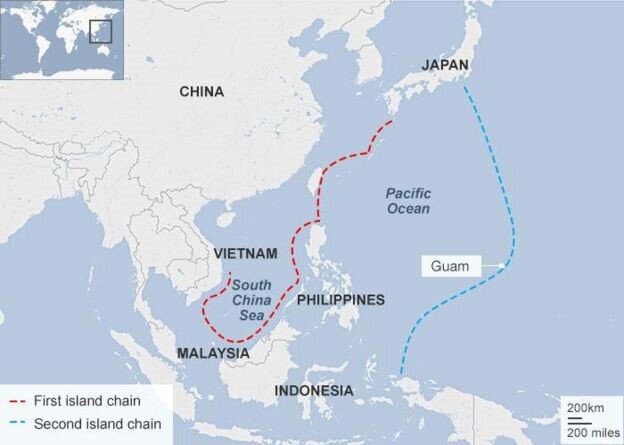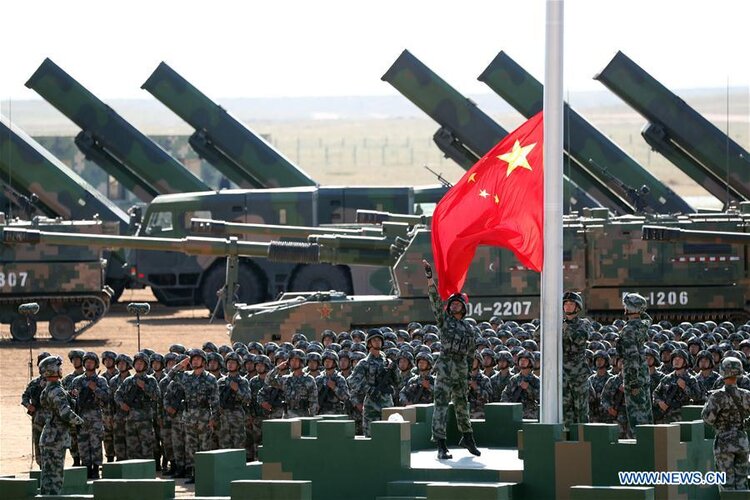Matthew Jamison
 China has developed a robust counter-intervention capability centered on missiles, aircraft, and ships. While there is room for scholarly debate as to whether counter-intervention is an official Chinese military strategy, it is clear China can prevent U.S. intervention in any Western Pacific crisis. To counter this capability, the Commander of U.S. Indo-Pacific Command, Admiral Philip Davidson, plans to increase investment in integrated air and missile defense systems. This shift in priorities is at the heart of Admiral Davidson’s new Regain the Advantage concept, billed in Congress as the Pacific Deterrence Initiative.[1]
China has developed a robust counter-intervention capability centered on missiles, aircraft, and ships. While there is room for scholarly debate as to whether counter-intervention is an official Chinese military strategy, it is clear China can prevent U.S. intervention in any Western Pacific crisis. To counter this capability, the Commander of U.S. Indo-Pacific Command, Admiral Philip Davidson, plans to increase investment in integrated air and missile defense systems. This shift in priorities is at the heart of Admiral Davidson’s new Regain the Advantage concept, billed in Congress as the Pacific Deterrence Initiative.[1]
The focus of this article is a crosswalk from China’s counter-intervention strategy to the U.S. response. This article begins with a look at what counter-intervention consists of and why it is important to China. A deep dive into U.S. response follows, emphasizing increased investment in integrated air and missile defense systems. The article concludes with a look at three other important considerations—allied support, budget, and the risk of escalation—along with a set of common-sense recommendations. To appreciate the importance of the Pacific Deterrence Initiative, and the essential role of integrated air and missile defense systems as a part of it, the reader must first understand China’s military strategy.
CHINA’S STRATEGY
China views its military capability as inherently defensive at the strategic level and offensive at the operational level. Accordingly, if China thinks an adversary is prepared to act imminently, it will not hesitate to preempt with offensive action to defend its national interests.[2] China’s focus on counter-intervention—commonly referred to as anti-access, area-denial—is reinforced by its weapons development programs, territorial claims, and political rhetoric.[3]
The intent of counter-intervention is first to deter intervention, then to degrade the adversary’s ability to intervene successfully to buy time to facilitate China’s accomplishment of its specific objective.[4]
View fullsize

The first island chain extends to Japan and the Philippines and includes the South China Sea; the second island chain encompasses Guam. (BBC)
The backbone of China’s counter-intervention strategy is a combination of its contested territorial claims and its continued weapons development. China has claimed ownership of everything within the so-called Nine-Dash Line, including the disputed South China Sea. It has built up artificial terrain features throughout the area, claiming man-made islands as Chinese territory. In militarizing this disputed area, China has deployed surface-to-air missile systems and multi-role fighter aircraft and has developed runways that can support both fighters and strategic airlift.[5] According to Ralph Sawyer from the University of Calgary’s Centre for Military and Strategic Studies, China’s occupation of the disputed Spratly Islands and others has enabled it to develop “stationary aircraft carriers and militarily buttress their claim to the entire South China Sea.”[6]
China is also employing non-military elements of national power, mainly economic, to expand its influence. China’s Belt and Road Initiative intends to do just that, creating influence through economic development projects that often saddle the recipients with debt and are seen by some as a cover for military expansion.[7] Belt and Road projects can help China gain influence and start to undermine the U.S. as the partner of choice within the region and beyond. Elizabeth Economy of the Council on Foreign Relations notes, “Under Xi, China now actively seeks to shape international norms and institutions and forcefully asserts its presence on the global stage.”[8] The U.S. has been particularly outspoken recently regarding the lack of validity in China’s maritime claims in the South China Sea, and the U.S. Navy regularly conducts what it refers to as Freedom of Navigation Operations to demonstrate the U.S. assertion that the South China Sea remains both free and open.[9]
The People’s Liberation Army maintains several weapon systems geared explicitly towards supporting a counter-intervention strategy. China’s Rocket Force has a robust inventory of ballistic and cruise missiles, many of which have maneuverable warheads, that serve as effective countermeasures to current missile defense systems. These missiles are capable of interdicting both ground-based and maritime assets throughout the first island chain and as far as the second island chain in more limited numbers.[10] Furthermore, China is a leader in developing and testing hypersonic missiles and unveiled the new Dongfeng-17 model during its recent 70th-anniversary parade.[11]
China’s Air Force has been upgrading its fighter and bomber fleet, with indigenously produced 5th generation-equivalent stealth fighters and bombers now capable of striking Guam with long-range missiles.[12]
Simultaneously, China’s Navy is aggressively building and deploying guided-missile cruisers, destroyers with Aegis-like capability, and submarines capable of launching anti-ship cruise missiles.[13] China similarly continues to augment its initial aircraft carrier with versions that are now entirely domestically produced.
In concert, China’s territorial claims, its expanded Rocket Force, and the aggressive development of Air Force and Navy weapon systems suggest a coordinated strategy to prevent outside intervention in a local conflict. Executed as intended, it allows China to threaten forward U.S. bases, challenge how the U.S. uses maritime power, and possibly discourage U.S. allies and partners from getting involved in a potential conflict. Andrea Ghiselli, from the School of International Relations at Fudan University, contends, “Waging war is far less necessary to defeat an enemy than in the past. Before any shot is fired, all the economic, diplomatic and military resources of the state are deployed in order to undermine the enemy’s strategy.”[14] Chinese leaders have carefully studied U.S. military operations and formulated counter-intervention specifically to impede U.S. power projection.
China’s primary operational target is Taiwan, and its focus extends to the United States in as much as it may get involved in Taiwan’s defense. The Chinese Communist Party has focused its military strategy on winning informationized local wars, which are intended to be short-duration, high intensity, geographically limited wars.[15] China also seeks to win the battle of information superiority, keeping its adversary from seeing what is happening on the battlefield and preventing it from exploiting any military mistakes. In practice, this would likely entail localized jamming of tactical data links and global positioning system, interference with the electromagnetic spectrum, and possibly limited employment of anti-satellite weapons.
In 2016, President Xi Jinping elevated the People’s Liberation Army’s Rocket Force to service-level status, highlighting its overall importance and critical role in nuclear and conventional deterrence and strikes. The rocket force would play a significant role in a Taiwan scenario through what it refers to as a Joint Fire Strike Campaign. It would conduct large-scale missile strikes against Taiwan as well as against U.S. forces and bases throughout the region.[16] The objective would be to “weaken defenses, either to create favorable conditions for subsequent campaigns, or in preparation for an amphibious invasion of the island.”[17]
View fullsize

President Xi Jinping urges the People's Liberation Army to spare no efforts to become a world-class military after inspecting troops in Inner Mongolia in 2017. (China Daily)
WHAT CAN THE UNITED STATES DO?
Developing the most effective means for overcoming China’s counter-intervention capability starts with increased investment in integrated air and missile defense systems.[18] Missile defense systems present the opportunity to most directly counteract China’s advancements in technology across the air, land, maritime, and space domains. To develop effective defensive systems capable of detecting, tracking, and engaging advanced threats from all azimuths, several missile defense and defeat concepts require focused investment.
Region-wide surveillance. If you cannot see it, you cannot hit it. This axiom necessitates birth-to-death search and track capability for all threats from a combination of space-based, maritime, and terrestrial sensors, as well as the ability to acquire and track maneuvering threats. Several systems in combination could meet these requirements and incorporate a necessary degree of redundancy, including the U.S. Missile Defense Agency’s Space Tracking and Surveillance System, the U.S. Navy’s Air and Missile Defense Radar, and the U.S. Army’s Forward-Based Transportable Surveillance Radars and Lower Tier Air and Missile Defense Sensor.[19]
Regional Automated Command and Control. A command and control system that provides an integrated fire control network—incorporating a secure, high-speed data path—enabling diverse systems of sensors, shooters, and communication to operate together within a modular, open system architecture. It should provide “any sensor, best shooter” solutions and be fully automatable based on the requirements of the operating environment, such as the ability to automate fires in a raid scenario. Ideally, it would support both joint and combined operations and be selectively multilateral.[20] The Department of Defense concept of Joint All-Domain Command and Control is a great start, and could build upon a system like the U.S. Army’s Integrated Air and Missile Defense Battle Command System or Australia’s Project AIR 6500 battle management system.[21]
Fixed, Mobile, and Expeditionary Defense. Systems must be capable of defending critical sites that support multiple, flexible concepts of employment, both enduring and short-term. Temporary, cost-effective solutions must enable the defense of potentially non-permanent operating locations. These employment concepts include Aegis Ashore to defend permanent sites, Aegis ballistic missile defense-capable ships or Patriot batteries to protect mobile or temporary assets such as aircraft carriers, alternate runways, or bed-down locations, and non-line-of-sight missiles in a box to support expeditionary operations.[22]
Offensive Fires. According to the famous American Civil War Admiral David Farragut, "The best protection against the enemy's fire is a well-directed fire by our own guns."[23] If China has to worry about defending its critical assets, it may be less able to focus its efforts on the attack. Long-range offensive fires should target static assets such as China’s integrated air defense system and possibly defeat offensive missiles before launch.[24] Deployment of long-range offensive fires could also potentially drive an increase in China’s defense spending or divert funds from other priorities.[25]
ALLIED CONSIDERATIONS
The United States assures allies and partners through forward presence and defense cooperation agreements. However, the U.S. military cannot defend all critical assets and protect all forward-deployed forces on its own. Leveraging the support of capable allies and partners is a crucial aspect of developing a comprehensive approach to disrupting China’s counter-intervention strategy. The 2019 Missile Defense Review says that the United States “will pursue cooperative relations with allies and partners to reinforce and advance missile defense architectures for our common protection, deterrence, and assurance.”[26] Key missile defense partners within the Indo-Pacific region include Japan, Republic of Korea, and Australia.[27]
The U.S. also relies on allies and partners to contest China’s territorial claims and to push back against the Belt and Road Initiative. In confronting China across all elements of national power, the U.S. must gain consensus from its allies and partners to maintain a united front in challenging China’s excess maritime claims and efforts to reshape international norms.
BUDGETS AND COMPETING REQUIREMENTS
Advanced missile defense systems employ cutting edge technology, which is not cheap. Military expenses will particularly be an issue in the post-COVID-19 world, where defense spending is likely to be constrained. Where possible, it is essential to leverage existing technology and multi-role systems to limit research and development costs and to reduce the cost of production—make something better rather than creating something new.[28] To that end, the Defense Advanced Research Project Agency’s Blackjack program seeks to leverage commercial satellites in low-Earth orbit for use as sensors.[29]
Despite a significant increase in missile defense funding in fiscal year 2018, the U.S. Missile Defense Agency’s budget has subsequently decreased, culminating in the president’s budget for fiscal year 2021 that put the figure at just shy of $9.2 billion.[30] With resources constrained, the Missile Defense Agency smartly canceled the Pacific Radar program, which would have created an additional target in the Pacific without adding the capability to defend it.[31] Leveraging partner contributions to regional missile defense will be critical in providing additional flexibility for U.S. missile defense spending.
RISK: DETERRENCE VERSUS ESCALATION
The line between deterring China from threatening a free and open Indo-Pacific and escalating crisis and conflict within the region is a particularly fine one.[32] The introduction of advanced missile defense systems within what China sees as its sphere of influence is likely to be perceived by China as an aggressive act. China was adamantly opposed to the 2017 deployment of an advanced missile defense system to South Korea even though it was a defensive system employed as a deterrent to North Korean aggression.[33] Furthermore, the presence of long-range, precision strike fires would add another layer of complexity. Engagement throughout the region utilizing the non-military elements of national power will be critical to effectively deter China, assure partners, and limit any corresponding escalation.
RECOMMENDATIONS
View fullsize

Admiral Philip Davidson in 2018 (AP)
Admiral Davidson’s plan for securing the Indo-Pacific is based on “fielding and sustaining a force capable of combat-credible deterrence that is postured…to win before fighting and, if necessary, be ready to fight and win.”[34] The first item on his $20 billion wish list for deterring China is a permanent and persistent missile defense system for Guam that can detect, track, and engage advanced threats on all axes. This system would incorporate many of the concepts outlined above—region-wide surveillance, regional automated command and control, and fixed site defense. Increased procurement of comprehensive missile defense systems is the best answer to China’s counter-intervention capability. While the short-term victory would be an advanced missile defense system capable of defending Guam, the long-term requirement for deterring China necessitates acquiring and employing the same systems on a much broader scale. This calls for the deployment of space-based sensors along with advanced maritime and terrestrial sensors. It requires robust development of the U.S. Army’s battle command system integrated with the rest of the joint force and allies throughout the region.[35] Combining these inherently defensive systems with the deployment of long-range precision strike systems puts China’s assets at risk and potentially forces a change in spending or operational employment. Finally, it is also vitally important to continue efforts to adapt existing systems and interceptors to counter emerging threats such as hypersonic weapons.
CONCLUSION
China’s counter-intervention capability presents a tremendous impediment to continuous U.S. military operations within the Indo-Pacific. Its South China Sea claims, underpinned by weapons development and efforts across the non-military elements of national power, are intended to ensure China’s freedom of action. A free and open Indo-Pacific relies on further development and deployment of U.S. integrated air and missile defense systems and offers the means for hindering China’s counter-intervention strategy. These recommendations provide a realistic approach to compete with China in multiple domains and to ensure access in the event of a regional crisis.
No comments:
Post a Comment